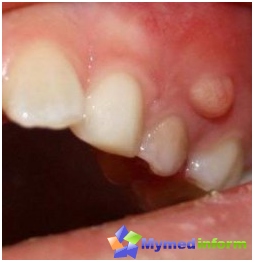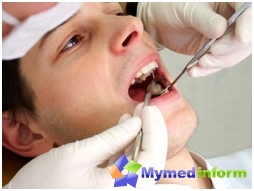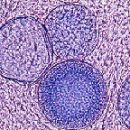Types of cysts teeth

Cyst translated from Greek means «bubble», It appears on the tooth as a protective reaction of the body to infection. It all begins with the fact that bacteria penetrate in the root canal, which provoke inflammation, it, in turn, kills infected cells and then space is formed in the cavity of the jaw. And to isolate healthy cells from the dead, the body forms a dense sheath in the cavity, and call it. Inside the capsule is inflammatory liquid. The size of the cyst is different: from a few millimeters to centimeters. Education up to half centimeter in diameter is called granuloma. You can only see it using an X-ray apparatus. The picture will be dark ovally stain, which has clear and smooth contours. Usually, cysts are on the root of the tooth or on the coronal part does not cut the tooth.
Cysts are divided into types according to the location and reasons for the occurrence. At the location, three cysts can be distinguished:
- On the front tooth.
- On the tooth wisdom.
- On the tooth in the gaimore sinus.
Based on the causes of the occurrence, all cysts are divided into:
- Radicular or on the root of the tooth. The cause of its occurrence is chronic periodontitis.
- Follicular. The cause of the occurrence - infection of the tooth, which has not yet cut down or a superkone tooth.
- Keratokystu. It appears due to a violation of the development of the tooth and consists of a chubmering fabric.
- Paradental. This is the cyst tooth wisdom, which appears if it is difficult to break and chronic inflammation occurs.
- Residual - arises after the dysfunctional removal of the tooth, if a piece of root remained in the gum.
- Embrellastic cyst - she is inherent in children from 7 years, who have an active change of teeth.
Sources and symptoms of cysts

Sometimes the cyst is not developing slowly, but rapidly, and cause such a growth jump can deteriorate the general condition of the body. All his strength immunity tightens to the hearth inflammation and comes the time when he is just «Tired» fight. If at this moment the body does not help, then the epithelium will begin to grow and the volume of fluid in the bubble will be rapidly growing. Launched, not treated cyst always leads to disappointing consequences:
- A limited focus of inflammation with a pus.
- Pathological fracture.
- Independent fallout tooth.
- Flux and Periosteit.
- In soft tissues, pus falls and phlegmon neck and face.
- The bone cloth of jaws is inflamed.
- Blood poisoning.
- Tumor of benign character.
- Crayfish.
The most dangerous cyst is considered during pregnancy, at that moment it is difficult to detect it, since the X-ray can not be done. It is a danger to a child and mother.
Treatment of cysts

Today, the dentistry stepped down so long that almost all treatment methods are aimed at preserving the tooth. A few years ago with such a diagnosis tooth was deleted. Treatment depending on the severity of the state passes in two ways:
- The therapeutic method, in this case, open the root canal, carefully clean it from the liquid and pus, is washed with special antiseptic means and seal. These medicines neutralize the cyst. But this method is effective for a cyst of no more than 8 mm in diameter.
- The surgical method in which the tooth leaves, but the tops of the root, which is covered by the cyst, is removed through the cut on the gum. The cyst doctor can either cut completely, if it is small, or insert her shell, if a big. After this procedure, the patient takes some time Antibiotics.
If the cyst was formed on the tooth of wisdom, then, as a rule, it is not preserved.
Treatment with folk remedies

Nobody and nothing can cope with the physician, but if you have any reasons for the dentist, then traditional medicine has its own ways to get rid of cysts.
- Ecoming garlic can help to kill all harmful bacteria, you need to dissolve every day of garlic for half an hour.
- Take advantage of the tincture of Mirra. In the half of the water you need to add 20 drops of the world, mix and rinse the mouth of the seconds thirty, twice a day.
- Stir half a teaspoon of soda in a glass of water, this mixture must be typed in your mouth and keep so long as soon as it turns out.
- Each time after taking food and cleaning the oral cavity, you need to rinse your teeth with brine. To do this, half a teaspoon of salt add to a glass of warm water. This solution will help to cope with the inflammation of the gums.
- Take 50 grams of alcohol, squeeze out of several sheets of ficus juice, and mix these two ingredients. Purl the mixture into a glass container and put in the refrigerator for a week to formed alcohol infusion. They need to rinse the oral cavity three times a day, but before that, the drug must be warm.
- Antiseptic properties have some essential oils, such as mint, almonds, bergamot. They must be diluted with water and rinse the mouth three times a day.
- Good disinfection and infusion of medicinal herbs. Add dried chamomile, yarrow, sage and calendula to alcohol. Let him be imagined and you can rinse your mouth, this medicine will help reduce inflammation near any tooth.
Treatment with folk remedies is better to be used as prevention, and with serious problems immediately go to the doctor.









